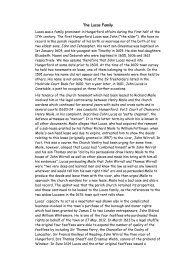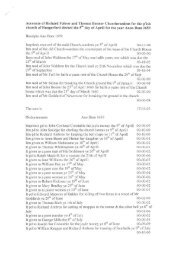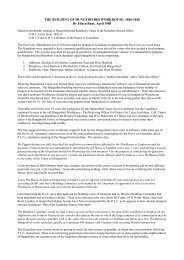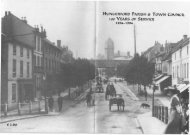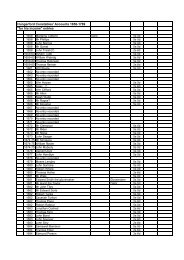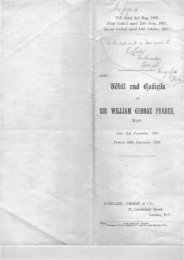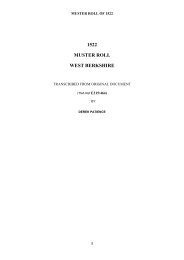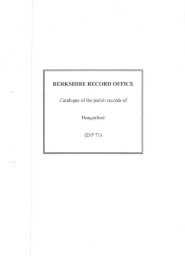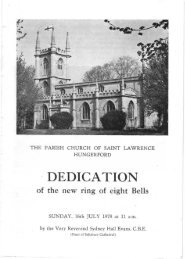The English Country House and Chilton Lodge - Hungerford Virtual ...
The English Country House and Chilton Lodge - Hungerford Virtual ...
The English Country House and Chilton Lodge - Hungerford Virtual ...
You also want an ePaper? Increase the reach of your titles
YUMPU automatically turns print PDFs into web optimized ePapers that Google loves.
perhaps that was the connection. Interestingly, Blomfield was also a Trustee of the Sir<br />
John Soane Museum.<br />
#11, 12<br />
Starting in 1892, Blomfield made fundamental alterations to the interiors of <strong>Chilton</strong> as<br />
well as adding a second storey to the mansion with ten maids' rooms; a most attractive<br />
porte cochere to the east; a large bachelor wing to the west; the coach house that forms<br />
the north wing of the stable block (in the Wrenaissance' style) <strong>and</strong> various garages <strong>and</strong><br />
machine shops. I suspect that it was he who ripped out every piece of Georgian<br />
plasterwork in the house, replacing the ceilings with rather boring Victorian coving.<br />
#13, 14, 15<br />
Pearce was also responsible for a major investment in the water supply for the house <strong>and</strong><br />
the estate. <strong>The</strong> pump house on the Kennet below the house dates from 1891. Turbines<br />
powered by the Kennet pumped water to the 40,000 gallon water tower built on the<br />
highest point of the estate, <strong>and</strong> thence to the main house <strong>and</strong> the outlying farms. All the<br />
water for the domestic supply at <strong>Chilton</strong> <strong>Lodge</strong> was fed through a building that acted as a<br />
giant water softener, filled with brine tanks. To give you an idea of the extent of this civil<br />
engineering, the water works cost Sir William £10,000, at a time when the whole estate<br />
was valued at £80,000. We are currently upgrading the system <strong>and</strong> our engineers<br />
constantly marvel at the quality <strong>and</strong> sophistication of the materials <strong>and</strong> workmanship<br />
used by their Victorian predecessors.<br />
#16<br />
Over the next few years, Sir William made other substantial additions to the housing<br />
stock on the estate, notably in <strong>Chilton</strong> Foliat <strong>and</strong> the dairy (now the estate office) <strong>and</strong><br />
lodges at the eastern <strong>and</strong> southern entrances to the park.<br />
I have great admiration for what Pearce achieved at <strong>Chilton</strong>. Certainly, he followed the<br />
fashion for enlarging the house, <strong>and</strong> its staff, but everything was done to a very high<br />
st<strong>and</strong>ard. We know from the Fire Brigade roster for the house that there were three<br />
footmen as well as a butler, two resident engineers, two odd job men, <strong>and</strong> two grooms, not<br />
to mention all the maids <strong>and</strong> housekeepers, gardeners <strong>and</strong> other estate employees.<br />
<strong>The</strong> tragedy is that, having been an MP for Plymouth (1892-5), <strong>and</strong> a JP for Berkshire <strong>and</strong><br />
Wiltshire, <strong>and</strong> having finally married in 1905, Sir William died in 1907 at the age of 46<br />
<strong>and</strong> without heirs.<br />
#17<br />
<strong>The</strong> house <strong>and</strong> estate were offered for sale in 1908. <strong>The</strong> particulars, that put modern<br />
estate agents' efforts to shame, show that the estate extended to 2,330 acres <strong>and</strong> had 73<br />
separate dwellings, including 8 farms. <strong>The</strong> rent roll from the let farms produced an<br />
annual income of £1,800!<br />
#18, 19, 20<br />
<strong>The</strong> estate was purchased in its entirety by <strong>The</strong> Right Hon. Mr. <strong>and</strong> Mrs. Whitelaw Reid<br />
for their daughter Jean <strong>and</strong> her new husb<strong>and</strong>, John Ward. Whitelaw Reid was the United<br />
States Ambassador to the Court of St. James at the time, <strong>and</strong> his wife, Elizabeth, was the<br />
daughter of DO Mills, a prominent <strong>and</strong> very successful banker who had made his pile in<br />
Northern California. DO Mills <strong>and</strong> his two brothers were originally from Buffalo, New York<br />
but moved west in the California Gold Rush of 1849-51. His brothers sold mining<br />
equipment, whilst DO contented himself with running a counting house at the back of the<br />
store. It eventually became part of the Bank of California.<br />
John Ward was the second son of Lord Dudley, whose family fortune had originated in the<br />
coalfields of the Midl<strong>and</strong>s, <strong>and</strong> who lived in considerable style at Witley Court <strong>and</strong> at<br />
Dudley <strong>House</strong> in London. As a younger son, John Ward's financial expectations would<br />
have been pretty slender but, thanks to a fortuitous marriage, he <strong>and</strong> his wife managed<br />
pretty well adding to <strong>Chilton</strong> <strong>and</strong> their estate in Scotl<strong>and</strong> over the next few years, a villa<br />
set in 40 acres at Cap Ferrat, a large flat in Paris <strong>and</strong> a house in Belgrave Square.<br />
Together, <strong>and</strong> one imagines with the help of Jean's mother, they indulged in some serious




